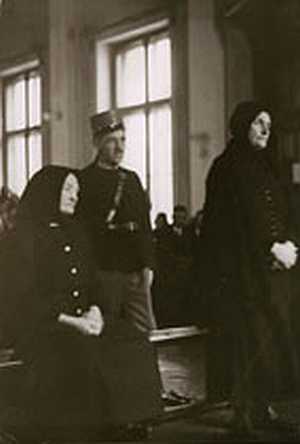This is the trailer for Chocolate, from Prachya Pinkaew, director of Ong-bak and The Protector, which made a super-star of Tony Jaa. It’s about an autistic girl who picks up martial-arts skills from TV and their next-door neighbours, a muay thai academy. She uses those skills to collect debts on behalf of her ill mother, which incurs the wrath of both local and Japanese gangs. As with Pinkaew’s earlier films, there is no wire-work or CGI – it’s all raw, athletic ability, and based on this trailer alone (or even the painful out-takes), it could be the best action heroine film of 2008. The Thai release is February 8.
Month: January 2008
The Angelmakers
★★★
“When the Blue Danube turned red…”
 You wouldn’t know it to look at the sleepy Hungarian village of Nagyrév [population: 872], but there was a time between the world wars when this was the murder capital of the world. Between 1914 and 1929, an estimated three hundred people were poisoned to death, using arsenic obtained by boiling down flypaper. The great majority of the murders were committed by local women, who wanted rid of their husbands; the local midwife, Julia Fazekas, was the source of the lethal materials. This was in an era when divorce was all but impossible, and many marriages were arranged; Julia offered a quick and painless (for the wife!) escape from a life of abuse and a loveless relationship. Since she was the closest the village had to a doctor, and her cousin was in charge of filing the death certificates, she and her accomplices got away with their crimes.
You wouldn’t know it to look at the sleepy Hungarian village of Nagyrév [population: 872], but there was a time between the world wars when this was the murder capital of the world. Between 1914 and 1929, an estimated three hundred people were poisoned to death, using arsenic obtained by boiling down flypaper. The great majority of the murders were committed by local women, who wanted rid of their husbands; the local midwife, Julia Fazekas, was the source of the lethal materials. This was in an era when divorce was all but impossible, and many marriages were arranged; Julia offered a quick and painless (for the wife!) escape from a life of abuse and a loveless relationship. Since she was the closest the village had to a doctor, and her cousin was in charge of filing the death certificates, she and her accomplices got away with their crimes.
All good things must come to an end, however. It’s unclear what triggered police action, but Fazekas knew the game was up, and by the time the police knocked on her door, she’d used her own poison to commit suicide. 26 of her associates, however, were taken to court; eight were sentenced to death, seven to life imprisonment and the remainder to various terms in jail. Eight decades later, Bussink returned to the village, and found some inhabitants still alive, who were around at the time, such as the 93-year old Rosika, in whose pantry one of the murderers hung herself from a nail. Her family then used the nail to hang bacon up.
It’s an not uncommon moment of gallows humour in the film (which puts the death-toll lower, at “only” 140). While Bussink initially met some resistance from the locals, they seem happy here to open up to her; the women, in particular, view past events with phlegmatic resignation. Maybe there’s something about Hungarian ladies; see also Vera Renczi, who murdered 35, including husbands, lovers, and a son early in the twentieth century, and of course, Countess Erzsebet Bathory. However, the film never really does more than scratch the surface, and the running-time is padded unnecessarily by shots of the local countryside, rather than providing more historical background. There’s a pointed, if very clumsy, allusion to modern times, with a local folk-dance club discussing the problems they have with their husbands.
The overall effect is to open the door on a largely-forgotten corner of murderous history, but Bussink doesn’t shine much light into the dark corner. There was word of a movie based on the topic, to star Helen Mirren, which shifted the location from Hungary to Yorkshire, with Anna Friel and John Hurt also involved, and Jon Sommersby Amiel as the director. [Curiously, Friel recently played Countess Bathory in another film] That was first announced in August 2006, but IMDB still shows it as “in development”, so who knows. I suspect the Hollywood fantasy will be nowhere near as bleakly murderous as the reality, somehow.
Biohazards
★★★
 If you thought the novel was a quick read, I got through Biohazards during lunch, and that’s only with 30 minutes. Still, being a comic-book, we must cut it some slack, though I can’t say I find action (and there’s a lot of it here) is something that works very well in panel form, lacking the true sense of motion you get in cinema. That said, I still didn’t hate this first entry in the trans-Pacific entry, in which Kei and Yuri are sent to investigate the kidnapping of an industrialist’s mind by his rival [literally: it’s on a chip]. Adding a little spice, both companies are knee-deep in dubious bioweapons, so who is the real villain here?
If you thought the novel was a quick read, I got through Biohazards during lunch, and that’s only with 30 minutes. Still, being a comic-book, we must cut it some slack, though I can’t say I find action (and there’s a lot of it here) is something that works very well in panel form, lacking the true sense of motion you get in cinema. That said, I still didn’t hate this first entry in the trans-Pacific entry, in which Kei and Yuri are sent to investigate the kidnapping of an industrialist’s mind by his rival [literally: it’s on a chip]. Adding a little spice, both companies are knee-deep in dubious bioweapons, so who is the real villain here?
It’s another different style, in some ways perhaps more Japanese than classic DP, though still with something alien to it, as if the artist had learned from one of those “Draw Manga” books. Which is less a knock on Warren than it probably sounds, being more an acknowledgement of how influential the Dirty Pair comics are [there was a time when manga was not to be found in Borders, y’know]. The in-jokes are actually more restrained than I remembered – and expected, after the very first page has a security guard singing the theme to Magnum of Love’s Destiny, a movie from the City Hunter series. But that was about it, unless “Power up the synthesizer, Neil” is a Rush reference? Hard to be sure…
There are some interesting nods to the original novels, such as Mughi’s ability to manipulate the electromagnetic spectrum, and Yuri’s Bloody Card weapon is almost exactly as described in Great Adventures. That may be the weakness here, in that Warren and Smith seem less intent on bringing anything new to the characters, than being faithful to the original texts. As the series progresses, however, that would become less of an issue, but while the first, this is certainly not the best, or most representative, of the US comics.
Story: Toren Smith and Adam Warren
Art: Adam Warren




